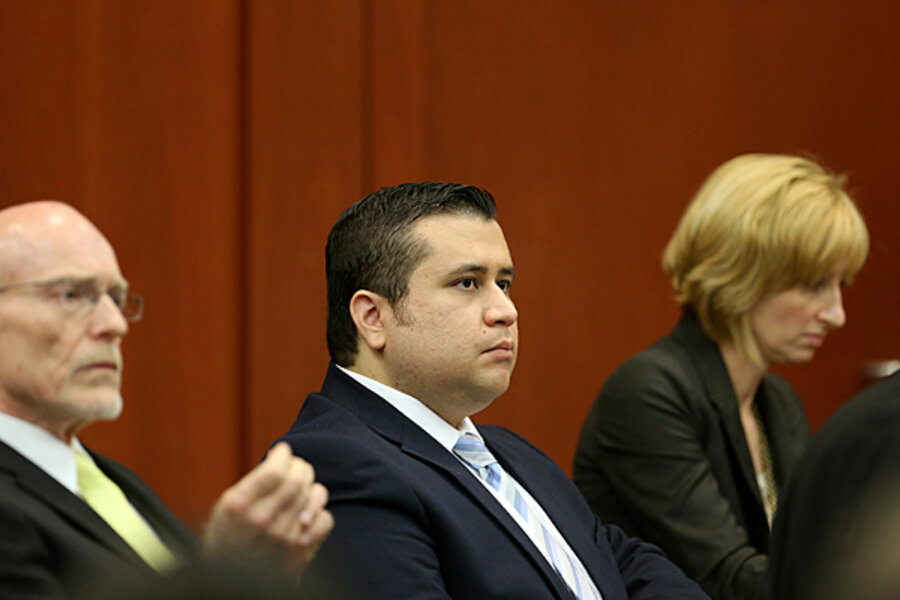Trayvon Martin case: Jury can hear five 911 calls from George Zimmerman
Loading...
| Sanford, Fla.
Lawyers prosecuting the Trayvon Martin shooting case will have an opportunity to sketch a portrait of defendant George Zimmerman, now that the trial judge has decided the jury can hear five of Mr. Zimmerman's nonemergency 911 calls to police. The calls could help shape jurors' impressions of Zimmerman, who is on trial in Florida for second-degree murder, as either a seething vigilante or a stand-up community organizer.
Zimmerman is on trial for shooting an unarmed black teenager named Trayvon Martin to death on the drizzly evening of Feb. 26, 2012. He had made at least 50 such calls to police over an eight-year span leading up to the shooting, to report things like slow-moving vehicles and loitering by strangers in his gated Retreat at Twin Lakes neighborhood here in Sanford, Fla. Circuit Court Judge Debra Nelson ruled Wednesday that prosecutors can play five of the calls in court.
Trayvon was returning to the neighborhood home where his father was staying, toting an iced tea, a bag of Skittles, and $40 in his pocket, when Zimmerman got out of his car to investigate, before a 911 dispatcher told him, “We don’t need you to do that.”
The moment before Trayvon’s death remains murky. As a result, the perceived characters of the teenager and of the defendant loom large in the trial, forcing Judge Nelson to tread carefully. More-direct investigations of Zimmerman’s and Trayvon’s characters could enter the trial, now in its third week, if either side raises issues that could be explored by the other side.
The judge has previously ruled that the jury won’t be able to consider social media interactions by Trayvon that describe pot-smoking, guns, and a fascination with martial arts fighting. The defense had said that, similarly, the 911 recordings of Zimmerman are immaterial because they don’t pertain to the moments before Trayvon was shot.
But prosecutors say the 911 calls show what they characterize as Zimmerman’s zealous, angry mind-set and “ill will.” The calls “show the context in which [Zimmerman] sought out his encounter with Trayvon Martin,” prosecutor Richard Mantel told the judge before her ruling.
The opening statement from the prosecution on Monday included a profanity-laced string of words Zimmerman can be heard syaing on a 911 recording of the moments before Trayvon was shot, including the phrase, “These [expletive] always get away.”
“He shot [Tryavon] for the worst of all reasons: because he wanted to,” prosecutor John Guy said.
In testimony Tuesday, Sanford Police Department’s former community watch organizer, Wendy Dorival, added texture to the debate about Zimmerman’s character.
On one hand, she said, watch members are specifically instructed to call police and stay away from potential crimes in progress. But she also called Zimmerman conscientious and professional, and noted that she had, in fact, asked him to take part in a second neighborhood watch group because of his work organizing the unit in the Retreat at Twin Lakes.
Zimmerman, now 29, worked for an insurance company before his arrest, and had been enrolled in a law enforcement program at a local college. He aspired to be a police officer.
Zimmerman’s supporters say evidence that Trayvon aspired to be a fighter is relevant, because it could explain and corroborate Zimmerman’s version of events – that Trayvon decided to attack Zimmerman, at which point Zimmerman was within his legal right to defend himself with deadly force.
Trayvon's supporters say the teenager, in any case, was within his right to try to defend himself against an armed man following him for no reason.
Zimmerman has claimed that he got out of his car to check his location when Trayvon attacked him, broke his nose, and then began to beat his head against the sidewalk. He has said he didn’t realize Trayvon was a minor, and wasn’t sure if Trayvon was armed. He has also said Trayvon said, “You are going to die tonight” before wrestling for Zimmerman’s gun. Zimmerman says he got to the gun first, and fired a single bullet into Trayvon’s chest.
On Tuesday, the jury saw the clothes both men wore on the night of the shooting, including Trayvon’s gray hoodie, which has become symbolic of a case that has sparked fervent debate about racial profiling, self-defense laws, and the extent to which liberalized gun-access laws invite unnecessary violence.









